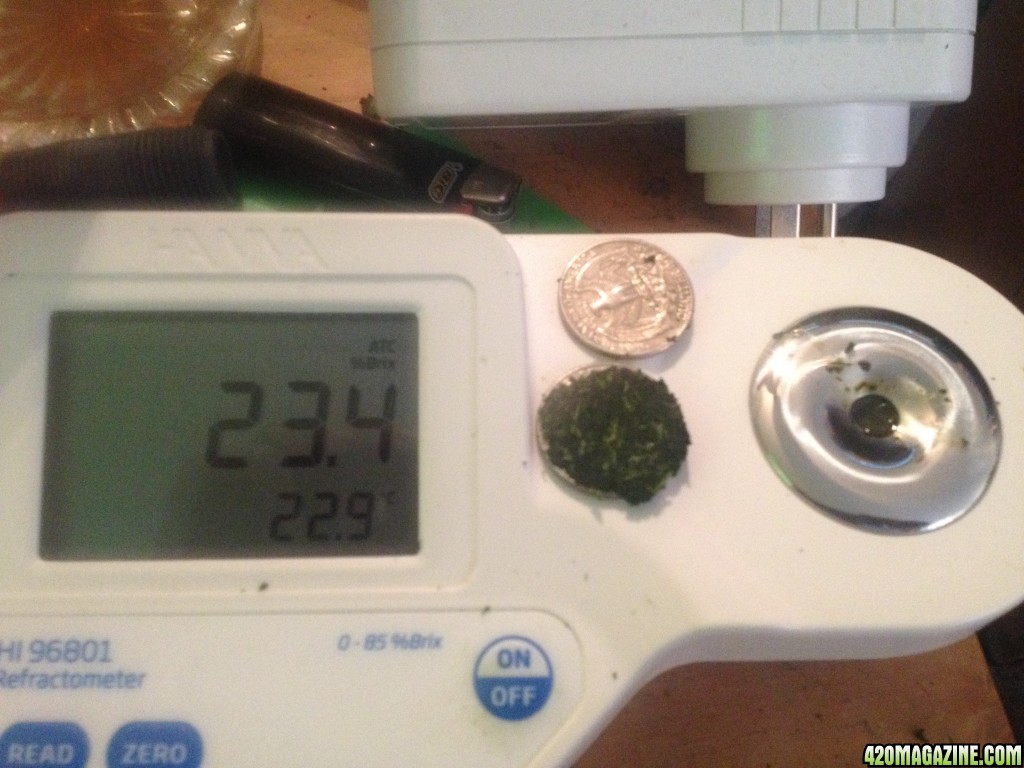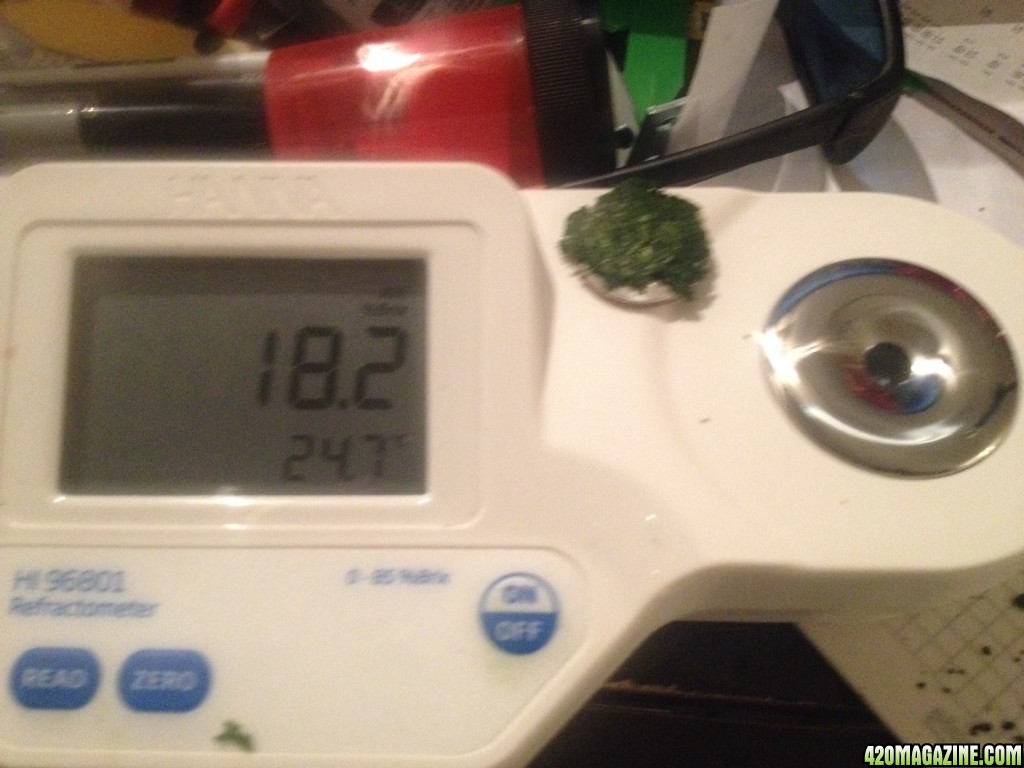Navigation
Install the app
How to install the app on iOS
How To Use Progressive Web App aka PWA On 420 Magazine Forum
Note: This feature may not be available in some browsers.
More options
You are using an out of date browser. It may not display this or other websites correctly.
You should upgrade or use an alternative browser.
You should upgrade or use an alternative browser.
A top nutrient study - Which is the best? Produces most?
- Thread starter ledtester
- Start date
Heatheree707
New Member
Thank you....super interesting read. Ever try Humboldt County's Own or House & Garden nutrient lines? Just curious...
jamesleemc
Well-Known Member
i did a few of these, and stoped with general organics , but then had a rep from Aurora Innovations call me and i tryed their stuff on a side by side with G O and ADVANCED AND NOW I ONLY USE Aurora Innovations SOUL LINE killer stuff.......
Hi brix baby.. Veg brix tested today
lowest and highest


ATC is not what they make it seem to be. Brix will be higher at lower temps and lower at higher temps.
With Earth Juice you focus more on maintaining a healthy living medium. The "Grow" gets premixed in a small container so I can viciously shake the hell out of it - then add it to the solution. This tea can last some time with air being pumped in - sometimes a week. It's time consuming but well worth the effort. pH must be balanced prior to application.
I know that this article is old, but felt like I needed to reply. Awesome information and a wealth of knowledge. Thanks so much for your contribution. I am unsure about one thing though. I have been using Earth Juice for a few years and it is my understanding that you do not have to adjust the pH. I got this right from their website. Begin quote"14. I mixed a solution using the Earth Juice Original Formulas "Advanced Chart" and my pH is 3.90?
Earth Juice will work in harmony with the medium and self adjust.
Since 1991, the mass majority of gardeners — including us — who use the Earth Juice Original formulas simply mix with water and use without adjusting the pH.
The initial pH of Earth Juice Original formulas will generally be on the mild acidic side. This is primarily due to the natural extracts, phyto-acids and protein (amino) acids contained in Earth Juice formulas. Earth Juice will self-adjust as it breaks down in the medium. In general terms: primarily by releasing naturally chelated Calcium along with Potassium and natural occurring beneficials. These various elements will aid in buffering the natural and beneficial phyto-acids (weak acids)." End quote you can find this at the Earth Juice faq page. I normally pH balance my water before mixing my nutes. Any input is appreciated.
Thanks all.
Blueslinks85
New Member
After compiling the above products and developing each feeding schedule I used the above additives within each 12 plant per schedule set-up. As an example, a consistent, predetermined amount of Hygrozyme was added to 1 plant in each cycle - in the Advanced Nutrient case I removed the use of Sensizyme. This gave me results even among the 2 enzyme formulas in that test. 1 plant was also giving Cal/Mag +, 1 Safergro Calcium and so on. This gave me an immense amount of feedback but also resulted in many "head to head" additive comparisons. I could not only determine nutrient/ingredient effectiveness but additives turned out to be the most apparent differences in the test. Above all else I felt my conclusions would lead to a better understanding through recordable growth of not only which nutes but which ingredients resulted in more vigorous growth per what stage the plant was in. Generally speaking, I have a relatively non-scientific approach to growing, although I'm an avid researcher and meticulous when it comes to recording results my priorities tend to be instinctively straight forward in reference to what things I decided to monitor and record. Much of my data is based on actual numbers, however, I also had a number of items I recording on a opinion based numerical rating - basically 1 through 10 - 10 being the best. These numbers would be averaged out in the final stages to determine some overall conclusions. More importantly, they were also studied to specifically determine what grew the best plants in which stage. In addition to numbers I also included any pertinent notes in my weekly observations. The following measurements and ratings were taken every 4 to 5 days through-out the plants life.
Measurements:
Main stock circumference
Overall width
Plant overall weight (prior to feeding/watering)
Weight in lost foliage (if any)
Tallest major bud site
Shortest major bud site (this would help in determining growth consistency)
Weight in clippings and fan leaves at harvest
Weight in final product
Ratings:
Resin production
Crystallization
Color and/or bud color
Over-all structure (remained the same through-out)
Vigor
Bud odor
Deficiencies
Toxicities
Root structure rating
Aesthetics of final product
Taste of final product
Smoke rating
Price per gram produced
Each nute program was broken into an 80 day cycle resulting in roughly 5 to 6 "vegetative" applications and 8 to 9 "flowering" applications. The results are not easy as simply spitting out numbers. This entire process was designed to create the best compiled nute program through analyzing the ingredient effectiveness at specific growth stages. As my schedules were similar in overall nutrient intensity I expected similar eventual results and that's exactly what they did. Remember it's important to develop a sense of the total nutes applied per cycle and how you choose to give these nute's to the plant. Taking pieces from each schedule and plugging them into the growth stage that they excelled at will lead to over fertilization and throw the nute "curve" off. As complicated as this process was, I new deciding on a basic and effective cycle was the ultimate goal.
Before reading the observations it's important to understand some general organic microbial life. Microbes make up the majority of soil life in nature. Bacteria, fungus, nematodes, algie and many other micro organisms live in soil. In these tests I was primarily concerned with Bacteria and fungus. Bacteria are usually single celled creatures that prefer generally higher pH environments. There are literally billions and billions of them, some thrive in low oxygen soil (anaerobic) and others need air to properly thrive (aerobic). Bacteria need water to live producing a slime of sorts around them that binds the substrate together and preserves some moisture required for it's survival. They are extremely good at decomposing organic matter by producing enzymes that break down nutrients. The enzymatically digested nutrients are then absorbed back into the bacteria. Fungus is similar in that it also uses enzymes to decompose matter but has some unique characteristics. First, it produces Chitin. This is the same biological substance used in crab and various sea shells and the exoskeletons of many insects. Chitin gives fungus stiffer and a more resistant cellular make-up than bacteria. These fungus cells combine into chains and have passageways between them. This allows fungus to transport fluids from one end of it's chain to the other. I'm sure many of you have heard of Mycorrhizal fungi for example, which encircles and sometimes attaches to root systems searching for food and water on it's own by expanding beyond the plants regular capacity, then transports the nutrients back to the roots. Root's will exchange these nutrients for carbohydrate rich fluids called Exudate's. These exudate's are imperative to producing chitin. The important feature here is that the plant chooses when to exchange the nutrients hence giving a healthy plant more natural control over it's own growth. It also means that this fungus will become an extension of root systems leading to more efficient nutrient absorption. When fungus and bacteria absorb a nutrient, that nutrient becomes locked inside them. They don't release this nutrient until exudate exchange or death. This means nutrients have more of a lasting and natural effect creating a humus rich, nutrient available medium. There are books based on this subject so I won't get to deep into it, but I feel promoting a strong microbial life in organic applications is my primary priority. I'll frequently refer to this microbial life, explaining it further. Plants are not totally depended on these methods of nutrient absorption. They can produce they're own enzymes also, just not nearly as efficiently.
I also think understanding " Brix " content can have benefits in comparative tests. Brix is a measure of a combination of various amino acids, oils, proteins, flavonoids, minerals and primarily sugars/carbohydrates within a plant's tissue. Many vineyards and fruit farmers use Brix levels to determine flavor and nutrition values in grapes and fruit. Brix levels can expose some important features in regards to marijuana. It is a great way to monitor your plants health measured using a refractometer. Much in the same way light beams change direction under water a refractometer measures the change in light direction sent through a sample of extracted fluid from the plant. The larger the direction change, the higher the Brix. Basically, as nutrient absorption occurs (specifically carbs and sugars), measured Brix levels rise. If the appropriate ingredient is poorly absorbed Brix levels will remain the same or lower. With that theory in mind we can better determine how well different nutrients react with Marijuana. Interestingly, organic mediums and organic solubles produce much larger Brix numbers. Plants with high Brix numbers are healthy, more pest resistant and full of nutritional value. Essentially the healthier plant is naturally more resistant to pathogens such as insect infestation. Plant eating insects lack the internal organs to properly digest certain sugars (specifically a liver). Undigested sugars will eventually ferment into alcohol killing the insect or disrupting it's digestive system. High Brix typically implies high sugar content hence are generally more unattractive to these bugs. Weak, infested or diseased plants always have lower Brix numbers. High Brix will improve taste, resin production, odor and potency. I feel it's an underestimated value in regards to plant management. If your interested look into Dr. Reams.
--------------------------------------------------------------------------------
What pro mix did you use


